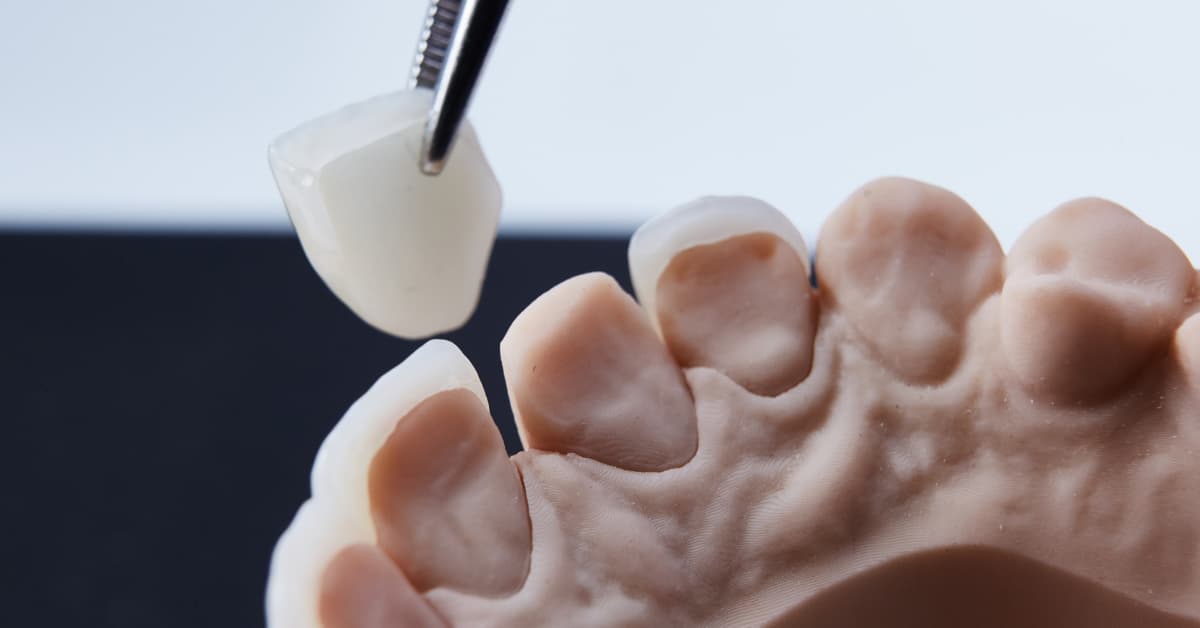How Often Should You Replace Dental Crowns?
Your dental crown has served you well for years, but lately you notice it feels different when you bite down. Maybe the edge seems rough against your tongue, or your floss catches in a spot that used to be smooth.
I’ve observed that most patients don’t think about whether they should replace dental crowns until something goes wrong – yet knowing when to replace a crown can save you from emergency dental visits and more extensive procedures.
Let me share what actually determines crown lifespan and the warning signs that indicate it’s time for replacement.
Key Takeaways
- Average crown lifespan ranges 10-15 years – but many last 20-30 years with excellent care
- Material matters significantly – Gold crowns outlast porcelain by 5-10 years typically
- Warning signs include pain, visible cracks, recurring decay, or gum recession around crown
- Preventive replacement beats emergency treatment – monitoring prevents tooth loss
- Insurance typically covers replacement after 5-7 years if medically necessary
What Determines How Long Your Crown Lasts?
Crown longevity depends on multiple intersecting factors that patients rarely consider until problems arise. The material your dentist selected plays a primary role. Gold and metal alloys demonstrate superior longevity, often lasting 20-30 years or longer. All-ceramic and porcelain crowns typically serve 10-15 years before showing wear. Porcelain-fused-to-metal falls between these ranges.
But material alone doesn’t tell the complete story. Your bite force and grinding habits impact crown survival dramatically. Patients who clench or grind – especially at night – may crack porcelain crowns within 5 years. Back teeth endure more pressure than front teeth, affecting replacement timing. A crown on a molar faces different stresses than one on a lateral incisor.
The underlying tooth condition matters equally. Crowns on healthy tooth structure last longer than those covering extensively damaged teeth. Root canal-treated teeth become brittle over time, potentially fracturing beneath crowns. The quality of remaining tooth structure when originally crowned influences long-term success.
Your oral hygiene directly affects crown lifespan through several mechanisms:
- Margin integrity – Where crown meets tooth remains vulnerable to decay
- Gum health – Inflammation leads to recession, exposing crown margins
- Opposing wear – Poor hygiene accelerates wear on crown and opposing teeth
- Supporting bone – Periodontal disease weakens crown foundation
When To Replace Dental Crowns: Recognizing Signs
Crowns rarely fail catastrophically without warning. Instead, they provide subtle signals that observant patients and dentists catch early. Pain ranks as the most obvious indicator, but the type of pain matters. Sharp pain when biting suggests a crack or loose crown. Throbbing pain indicates possible infection beneath the crown. Temperature sensitivity might mean margin leakage or recurrent decay.
Visual changes often precede functional problems. Look for these warning signs:
- Dark line at the gum margin (normal for metal-based crowns but may indicate recession)
- Visible cracks or chips in porcelain
- Crown appears longer than neighboring teeth
- Color changes or staining at crown margins
- Gap between crown and adjacent teeth
Functional changes deserve immediate attention. If your bite feels different or the crown rocks slightly when you push on it, the cement seal has likely failed. Food constantly packing around a crown signals an open margin where bacteria enter. Persistent bad taste or odor from a crowned tooth warrants investigation.
X-ray findings during routine exams reveal hidden problems:
- Recurrent decay – Shows as dark areas under crown margins
- Cement washout – Appears as space between crown and tooth
- Root fracture – Visible as dark line through root structure
- Bone loss – Indicates periodontal problems or infection
Sometimes crowns fail without obvious symptoms. Regular dental exams catch these silent failures before they cause tooth loss. Your dentist checks crown margins with explorer instruments, evaluates x-rays for hidden decay, and tests crown stability.
Different Crown Materials and Their Typical Lifespans
Material selection profoundly impacts replacement frequency. Each material offers distinct advantages and limitations affecting longevity.
Gold crowns represent the longevity champions. These crowns routinely last 20-30 years, with many functioning well beyond that timeframe. Gold’s malleability allows excellent margin adaptation. It wears at a rate similar to natural teeth, preventing damage to opposing teeth. The biocompatibility reduces gum irritation. The primary drawback? Aesthetics limit gold to back teeth for most patients.
All-ceramic crowns provide superior aesthetics but typically require replacement after 10-15 years. Modern ceramics like lithium disilicate show improved strength over older porcelains. Still, they remain more prone to fracture than metal-based options. Front teeth crowns last longer than molar crowns due to reduced chewing forces.
Porcelain-fused-to-metal (PFM) crowns combine durability with acceptable aesthetics, lasting 12-20 years average. The metal substructure provides strength while porcelain offers tooth-like appearance. However, porcelain can chip away from the metal over time. Gum recession may reveal the metal margin, creating aesthetic concerns.
Newer materials show promise but lack long-term data:
- Zirconia – Extremely strong, potentially lasting 15-25 years
- E-max – Beautiful and durable, estimated 10-20 year lifespan
- Composite – Budget option lasting 5-7 years typically
- Temporary materials – Designed for weeks to months only
The Crown Replacement Process: What to Expect
Replacing a crown follows similar steps to initial placement but with additional considerations. First, your dentist must remove the existing crown. This sounds simple but requires skill to avoid damaging the underlying tooth. Old crowns often resist removal, especially if well-cemented originally.
The exposed tooth reveals why replacement became necessary. Common findings include:
- Recurrent decay requiring removal
- Cracks needing evaluation
- Insufficient tooth structure remaining
- Old filling material breakdown
Your dentist cleans and prepares the tooth, which might involve:
- Decay removal – Clearing new cavities at margins
- Core buildup – Adding material if tooth structure is insufficient
- Crown lengthening – Surgical procedure if margins extend below gums
- Retreatment – Updating old root canals if needed
Sometimes the tooth cannot support another crown. Extraction might be necessary if:
- Decay extends too deep
- Vertical root fracture exists
- Insufficient tooth remains above bone
- Severe periodontal disease compromised support
When the tooth proves salvageable, your dentist takes new impressions or digital scans. Temporary crown placement protects the tooth during lab fabrication. Modern CAD/CAM technology enables same-day crown replacement in equipped offices.
Costs and Insurance Considerations
Crown replacement costs mirror initial crown placement, ranging $800-$2,000 per tooth depending on material and location. Additional procedures add expense:
- Core buildup: $200-500
- Crown lengthening: $600-1,200
- Root canal retreatment: $800-1,500
Insurance coverage varies significantly. Most dental plans cover crown replacement after specific intervals:
- 5-year minimum – Many insurers require this wait
- 7-10 years typical – Standard replacement allowance
- Medical necessity – Earlier if crown fails or breaks
- 50-80% coverage – After deductible, up to annual maximum
Documentation helps insurance approval. Your dentist should provide:
- Clinical photos showing damage
- X-rays demonstrating problems
- Narrative explaining medical necessity
- Treatment history of the crown
Out-of-pocket costs catch many patients unprepared. Consider these factors:
- Annual maximum limits (typically $1,000-2,000)
- Deductibles applying to major services
- Waiting periods for new insurance
- Downgrades to less expensive materials
Preventing Premature Crown Replacement
Maximizing crown lifespan saves money and preserves tooth structure. Simple habits make substantial differences.
Daily hygiene around crowns requires special attention. Crowns don’t decay, but the tooth underneath remains vulnerable. Focus cleaning efforts at the crown-tooth junction. Use fluoride toothpaste to strengthen exposed tooth structure. Floss carefully but thoroughly – crowns create ledges where plaque accumulates.
Night guards protect crowns from grinding damage. Even patients unaware of grinding often show wear patterns. Custom guards distribute forces evenly, preventing crown fractures. The $300-500 investment protects thousands of dollars in dental work.
Dietary choices impact crown longevity:
- Avoid hard foods – Ice, hard candies, nuts can crack porcelain
- Limit sticky foods – Can pull crowns loose over time
- Reduce acidic beverages – Erode cement and tooth structure
- Moderate temperature extremes – Rapid changes stress crown materials
Regular professional maintenance extends crown life significantly. Hygienists remove calculus buildup that traps bacteria. Dentists catch small problems before they require replacement. Professional fluoride treatments strengthen tooth structure at crown margins.
When to Replace vs. Repair Your Crown
Not every crown problem requires complete replacement. Understanding repair options saves time and money when appropriate.
Minor porcelain chips often polish smooth or bond with composite resin. Small chips that don’t affect function or aesthetics might need no treatment. Larger chips exposing metal usually indicate replacement need, as repairs rarely last.
Loose crowns sometimes re-cement successfully if caught early. The key? Immediate attention prevents decay underneath. Your dentist evaluates why the crown loosened – was it trauma, decay, or cement failure? Re-cementation works only with intact margins and no decay.
Situations demanding replacement rather than repair:
- Recurrent decay – Cannot clean adequately under crown
- Margin gaps – Allow continuous bacterial invasion
- Major cracks – Compromise crown integrity
- Poor fit – Causes ongoing problems
- Aesthetic failure – When appearance matters most
Planning Your Crown Replacement Strategy
Smart patients plan crown replacement proactively rather than reactively. If your crown approaches 10-15 years old, discuss its condition at routine visits. Ask your dentist to document any changes with photos. Budget for eventual replacement, especially if multiple crowns near replacement age simultaneously.
Consider replacement timing strategically:
- Replace before major life events (weddings, job changes)
- Coordinate with insurance benefit years
- Address failing crowns before retirement
- Plan around extended travel
Track your crown history. Document:
- Placement dates
- Materials used
- Any problems experienced
- X-rays showing changes over time
This information helps predict replacement needs and supports insurance claims. Many patients forget crown ages until problems arise.
Take Control of Your Crown’s Future
Your dental crown represents a significant investment in oral health and function. While no crown lasts forever, understanding replacement timing helps you plan appropriately and avoid emergencies. Watch for warning signs, maintain excellent hygiene, and work with your dentist to monitor crown conditions.
If your crown shows any concerning symptoms – pain, looseness, or visible damage – schedule an evaluation promptly. Early intervention often allows simpler solutions. For crowns approaching 10-15 years, discuss their condition at your next cleaning. Proactive replacement beats emergency treatment every time.
Remember, crown replacement is normal maintenance, not failure. With proper care and timely replacement, crowned teeth can serve you well for decades. Take action to protect your investment and maintain your healthy smile for years to come.



